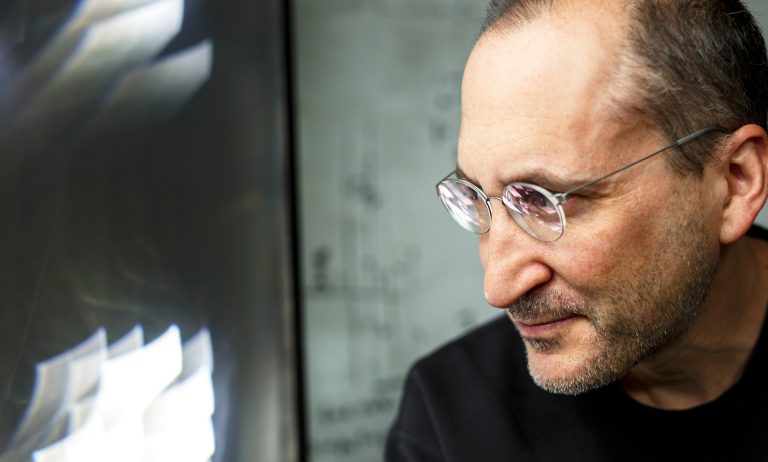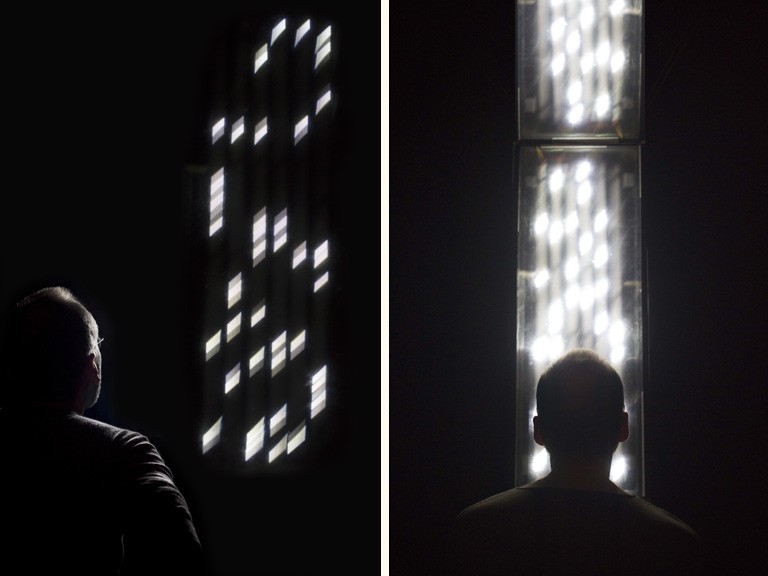Concordia’s Chris Salter rewires culture at London’s Barbican Centre

Concordia’s Chris Salter has enjoyed a long and fruitful relationship as creative consultant, researcher and artist with the Barbican Centre in London, England. His association will culminate on May 15 with the unveiling of his new artwork, called “Totem,” as part of the centre’s AI: More than Human exhibition.
A 14-metre light installation, the piece’s sensors scan the environment and feed this sense data to mathematical equations that model the behaviour of biological neurons.
“‘Totem’ asks whether an artificial entity can develop autonomy and consciousness,” explains Salter, computation arts professor and Concordia University Research Chair in New Media, Technology and the Senses.
“The neurons’ continually changing connections and behaviour influence but do not determine the installation’s moods — sleeping, hallucinating or angry — which are all expressed by dynamic and hypnotic changes in the light’s rhythm and intensity.”
Salter created “Totem” in collaboration with Sofian Audry (PhD 10), ALife expert Takashi Ikegami, current PhD candidate Alexandre Saunier and Berlin-based architect Thomas Spier. The work was commissioned by the Barbican Centre and supported with research-creation funds from the Fonds de Recherche du Québec - Société et Culture.
The Barbican’s AI: More than Human exhibition is part of the centre’s 2019 seasonal program called Life Rewired, which explores what it means to be human when technology is changing everything we do.
A massive culture shift toward interdisciplinarity
Salter, director of Hexagram Concordia, has been working with the Barbican since 2016.
His creative consultancy work on Life Rewired was the catalyst for an ambitious project at Europe’s largest arts centre. It initiated a massive institutional culture shift aimed at promoting interdisciplinary collaboration.
“I was invited into this project partly because of what we’ve done with Hexagram and the Milieux Institute at Concordia, where there is a real understanding of interdisciplinary projects and institutions,” Salter says.
At the Barbican, both the building’s architecture and its work culture put its five divisions into silos, Salter says. Until he got involved, its cinema, theatre, visual arts, education and contemporary classical music divisions had rarely worked together on a large-scale project during the institution’s 37-year history.
 Photos by Agustina Isidori
Photos by Agustina Isidori
Grappling with huge changes in a knowledge society
In 2016, Salter began working with senior Barbican producer Sidd Khajuria and Chris Sharp, the contemporary music programmer in charge of special projects, to develop the interdisciplinary project.
He presented a 50-page research document to the arts divisions and the marketing and communications departments.
“I showed them what institutions of their size and calibre did over the last five decades when they tried to respond to a zeitgeist. I did a large amount of research on projects that tried to grapple with a change in a knowledge society.”
The goal was to get each unit thinking about how a broader theme could be introduced into their own programming and where that programming might intersect.
“This is the classic problem cultural and academic institutions face: how do you provide autonomy to different arts departments at the same time as knowing the bigger picture?”
But institutions like the Barbican don’t change on a dime, Salter says.
“We didn’t want to impose something on the different arts departments. We made thematic suggestions and it was an iterative process.”
The trio encouraged small changes in work habits that had a big impact institutionally across all units at the centre. Through a measured, bottom-up, top-down process, units discovered new methods to remain focused on their programming but also engage with the larger seasonal theme.
Capturing the attention of 1.5 M people
Salter is also the co-creator of the Life Rewired Hub, a new, flexible multidisciplinary space on the main floor of the Barbican — similar to Concordia’s 4TH SPACE — that acts as a ground-floor gateway to all the thematically linked events at the Barbican.
One and a half million people walk through the Barbican’s public spaces in a year. Often they are going to see something specific but they don’t know about the bigger thread, explains Salter.
Since Khajuria runs a division called the Incubator, charged with reinventing the Barbican’s public spaces, creating the Hub gave them a physical space to bring the units closer together.
“I said to Sidd and Chris, we need glue to link individual events to the larger theme,” says Salter.
“The public spaces are a kind of neutral zone where different audiences mix. We thought this is the place where things could happen.”
Salter is one of the programmers of the Hub, which hosts a series of events directly in the public spaces: talks, performances, workshops and residencies as well as a selection of books related to the season.
“I’m looking forward to seeing the Hub in action. I think it definitely seems to have shifted certain organizational ways of thinking there,” he adds.
After nearly three years developing a close working relationship with staff at the Barbican, Salter is happy with the outcome — and he believes they are too.
“It’s been a long journey! I think the culture has changed at the Barbican Centre. They are planning another thematic season and I hope to work with them again in the future.”
Check out the Barbican Centre’s Life Rewired program.
Find out more about Concordia’s Department of Design and Computation Arts.


